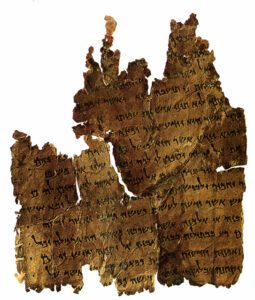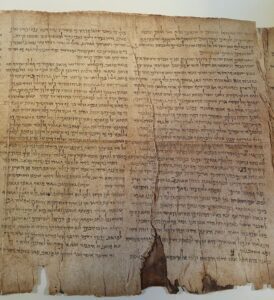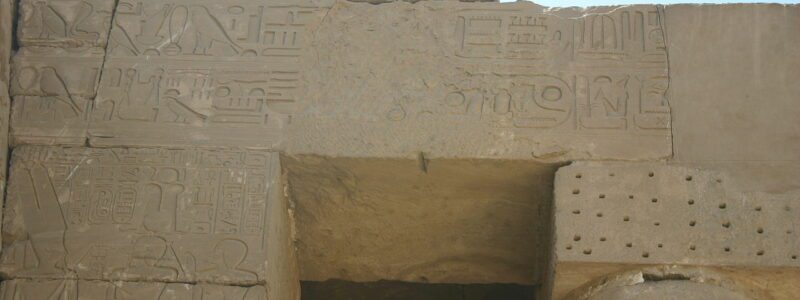Hebrew Writing Prior to Babylonian Invasion

By https://www.loc.gov/exhibits/scrolls/images/damasc-b.jpg – Library of Congress, CC0, Link
Skeptics have proposed the Old Testament story was written after the Babylonian Invasion. They support this belief with the conventional wisdom that writing was not common until after the Invasion.
The age of the Old Testament has been controversial between those who believe in the literal truth of the Old Testament versus secular scholars who believe it to be a relatively new invention.
A recent study published in Proceedings of the National Academy of Sciences suggests the Hebrew Bible is older than most believed. The study was performed at the Tel Aviv University in Israel and analyzed multi-spectral images of sixteen ancient Hebrew inscriptions.
The letters are written in the ink of broken pottery shards (ostraca) using a proprietary software program specially designed for this purpose. The ostraca itself dated back to 600 BC and was originally found at the Judahite fortress of Arad in southern Israel. This would be just before Nebuchadnezzar’s destruction of Jerusalem.
Hand Writing to Determine the Age of the Old Testament
The study’s authors could discern at least six different handwriting styles on the ostraca concerning the movement of troops and food expenses.
The authors note that the letters were likely not written by professional scribes but by less educated army officials. The authors note,
The results indicate that in this remove fort, literacy had spread throghout the military hierarchy, down to the quartermaster and probably even below that rank.
Now our job is to extrapolate from Arad to a broader area. Adding what we know about Arad to other forts and administrate localities across ancient Judah we can estimate that many people could read and write during the last phase of the First Temple period. We assume that in a kingdom of some 100,000 people, at least several hundred were literate.
Scholars have debated whether the Old Testament was written after the Babylonians destroyed Jerusalem or much earlier. However, literacy was more widespread in ancient Israel than previously thought, as the texts were written before the Babylonian invasion.
The authors argue that there is enough evidence on these ancient ostraca to conclude that.
already by 800 BCE there was sufficient intellectual infrastructure, that is, well-trained scribes, able to produce sophisticated historical and literary texts.
But Wait – There’s More!
The recent discovery of even more ancient Hebrew writing dating back to the 10th century BC places it within the reign of King David. This would support the opinion that Scripture was written centuries earlier than previously thought.
The oldest parts of the Bible were likely written down in an early form of Hebrew (“proto-Hebrew”) that would be difficult, although not impossible, for modern Hebrew readers to interpret.
Gershon Galil a professor of Biblical Studies at the University of Haifa in Israel, noted,
It [the inscription] indicates that the Kingdom of Israel already existed in the 10th century BCD and that at least some of the biblical texts were written hundreds of years before the dates presented in current research.
The writing was discovered on a pottery shard during excavations at Khirbet Qeiyafa near modern Israel’s Elah valley. Archaeologist Yosef Garfinkel of the Hebrew University of Jerusalem carried out these excavations. The inscription was difficult to interpret at first, but Galil was finally able to interpret the text. He notes,
It uses verbs that were characteristic of Hebrew … which were rarely used in other regional languages. Particular words that appear in the text … are specific to Hebrew and are written differently in other local languages.
The text is written in ink on a shard of pottery about 6 inches by 6.5 inches and appears to be a social statement about how slaves, widows, and orphans should be treated. It translates to,
you shall not do [it], but worship the [Lord]. Judge the slave and the widow, judge the orphan and the stranger. Plead for the infant, plead for the widow. Rehabilitate the poor at the hands of the king. Protect the poor and the slave, support the stranger.
The context is similar to Biblical scriptures.
Summary Concerning Literacy Prior to the Babylonian Invasion
The importance of his article can hardly be overstated. Many modern scholars believe Jews in the second or third century BC were authors of the Old Testament. Secular scholars argue this dating due to the prophetic nature of much of the Old Testament material – being secular, accurate prophecies can not have been written before the prophetic events. This particularly concerns the major prophets Daniel, Ezekiel, and Isaiah.
However, most modern evangelical Christians would agree the Old Testament was almost certainly written before the Babylonian destruction in 586 BC.
While we have the Isaiah Scroll found with the Dead Sea Scrolls that have carbon-dated to about 300 BC, we do not have ancient Daniel or Ezekiel scrolls.
Secular scholars, in particular, have doubted the portions of Daniel, which predict in great detail the Greek rulers over second BC Israel could have been written before the events. These new studies of Biblical archaeology give scientific credence to the ancient origins of prophetic scripture. Writing was not restricted only to the scribe class but was more common throughout society.





